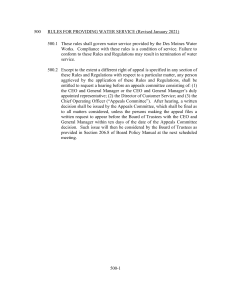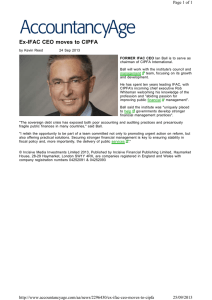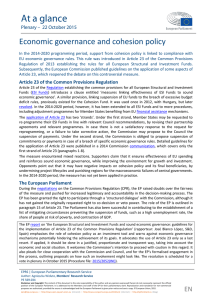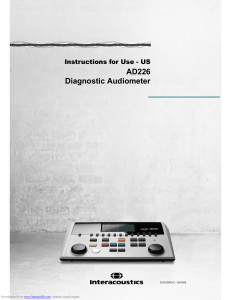CEO and Chairman: Are Two Heads Better Than One?
Anuncio
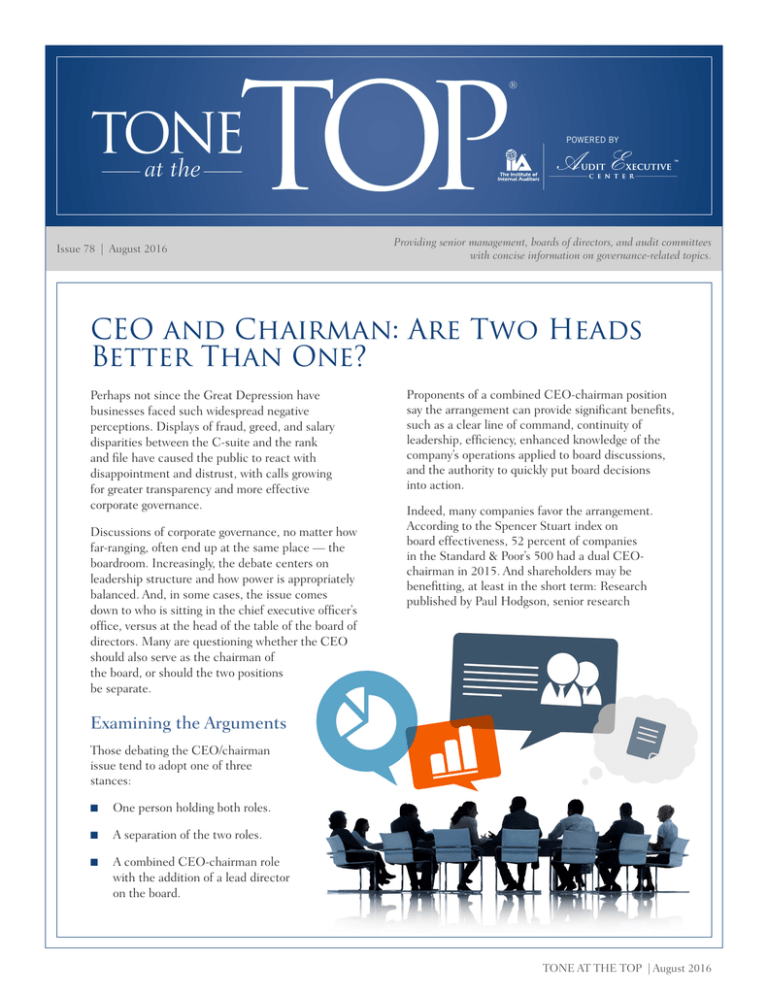
TOP ® TONE at the Issue 78 | August 2016 POWERED BY Providing senior management, boards of directors, and audit committees with concise information on governance-related topics. CEO and Chairman: Are Two Heads Better Than One? Perhaps not since the Great Depression have businesses faced such widespread negative perceptions. Displays of fraud, greed, and salary disparities between the C-suite and the rank and file have caused the public to react with disappointment and distrust, with calls growing for greater transparency and more effective corporate governance. Discussions of corporate governance, no matter how far-ranging, often end up at the same place — the boardroom. Increasingly, the debate centers on leadership structure and how power is appropriately balanced. And, in some cases, the issue comes down to who is sitting in the chief executive officer’s office, versus at the head of the table of the board of directors. Many are questioning whether the CEO should also serve as the chairman of the board, or should the two positions be separate. Proponents of a combined CEO-chairman position say the arrangement can provide significant benefits, such as a clear line of command, continuity of leadership, efficiency, enhanced knowledge of the company’s operations applied to board discussions, and the authority to quickly put board decisions into action. Indeed, many companies favor the arrangement. According to the Spencer Stuart index on board effectiveness, 52 percent of companies in the Standard & Poor’s 500 had a dual CEOchairman in 2015. And shareholders may be benefitting, at least in the short term: Research published by Paul Hodgson, senior research Examining the Arguments Those debating the CEO/chairman issue tend to adopt one of three stances: ■■ One person holding both roles. ■■ A separation of the two roles. ■■ A combined CEO-chairman role with the addition of a lead director on the board. TONE AT THE TOP | August 2016 associate at GMI Ratings, a corporate-governance research firm, found in 2012 that investors enjoyed a 12 percent return in the first year of a CEOchairman setup, compared with a return of a little more than 2 percent under a separate CEO and chairman structure. By the third year, the return under a CEO-chairman soared to 104 percent, compared with a 95 percent return where the positions were not joint. However, by the fifth year, shareholder return began favoring a separated structure. Those who prefer a separation of the two roles point to the negative aspects of the unified approach. “CEOs cannot be the bosses of themselves,” says Eleanor Bloxham, CEO of The Value Alliance and Corporate Governance Alliance, which provides board and senior executive education, information, and advisory services. “The CEO has a big enough job to do: managing the company. Leading the board is quite a different matter, requiring different skills and attributes.” Separating the two roles, advocates say, helps to eliminate the potential for actual or perceived conflicts of interest related to decisions about executive compensation, performance, and succession. Further, it enables the CEO to focus exclusively on matters related to successfully running the business, such as strategy and operations, they say. Proponents of the separated structure also have a practical argument in favor of keeping the two roles apart: the price tag. The most costly of the various iterations of governance structure is that of the combined CEO-chairman, according to Paul Hodgson’s research. Even so, researchers David F. Larcker and Brian Tayan of Stanford University’s Rock Center for Corporate Governance say there is still a relative lack of evidence supporting separate CEO and chairman positions. “Most research finds that the independence status of the chairman is not a material indicator of firm performance or governance quality,” they wrote in a research paper. Although a slight majority of S&P 500 companies in 2015 had a combined CEO-chairman, that was down sharply from 71 percent in 2005, according to the Spencer Stuart Board Index report. At the same time, the percentage of independent chairs tripled, 2 TONE AT THE TOP | August 2016 from 9 percent to 28 percent, according to the same report. Nevertheless, the split structure is still a minority practice. One hybrid solution may be the addition of a lead director to boards of companies that have a combined CEO-chairman role. A lead director, proponents of this option say, provides the checks and balances the board needs. In 2015, Peter Gleason, president of the National Association of Corporate Directors (NACD), listed several benefits of a lead director in his article, “Weighing the Benefits of a Combined Chair and CEO Role,” including: ■■ Identifying important and emerging issues, and ensuring they are addressed. ■■ Representing individual director perspectives to the CEO. ■■ Working with the nomination/governance committee to identify underperforming directors and supply resources to improve. ■■ Conducting executive sessions. The 2015–2016 NACD Public Company Governance Survey found that 56 percent of large-cap and 54 percent of mid-cap companies that have a combined CEO-chairman also have a lead director. Of course, as with any arrangement, much of the outcome may depend on the people involved and if the roles and responsibilities are well-defined. Indeed, the NACD has no official position on which structure is preferred. “Our view is that the key is not the structure; it’s having independence and objectivity on the board, no matter where those elements reside,” Gleason says. “The lead director position can be useful, but not if it is in name only. There have to be clearly defined roles and responsibilities for the lead director and the chair, and agreed policies for handling evaluation of the board, communication with the board, agenda setting, etc. — the things that ensure that the work of the board gets done.” Also important to the success of the arrangement is a strong lead director. Doug Anderson, IIA managing director of CAE Solutions, points out, “Otherwise, the CEO is likely to dominate the board, so the checks and balances the lead director is intended to provide are undermined.” Bloxham agrees that having the right people in the right seats is important. But, based on her work with boards, she says, “It matters who sits in the chair seat — and that person should not be the CEO. A board is much more likely to defer to the agenda of a CEO who is also the chair, rather than asking the tough questions that allow the organization to succeed.” Another reason the issue matters may be its potential effect on organizational culture, which studies show contributes to employee satisfaction, favorable reputation, and sustained profitability. Some believe a combined structure may damage organizational culture. “It’s tone at the top,” Anderson says. “The combined role is an inherent conflict of interest and the board is modeling that behavior to the enterprise.” Despite the differences of opinion on which arrangement is ideal, there is at least one area of consensus: Boards matter. Regardless of leadership structure, boards today must focus on setting the board agenda and ensuring their responsibilities are met and their fiduciary role is satisfied. Given the impact of those duties, future boards — and their leaders — are expected to remain under scrutiny by increasingly vigilant and empowered shareholders. Why It Matters Is this focus on CEO and chairman roles warranted? Former Federal Deposit Insurance Corp. chief Sheila Bair told Yahoo Finance, regarding if bank chief executives should also be board chairs, that “too much is made of separating these roles,” and “it’s really more about the people and whether they are competent and setting the right tone and culture.” Bair’s point could apply to corporate governance in general, not just board structure. In other words, the most important factor in effective corporate governance structure is that the right people in the right places are doing the right things. Quick Poll Question Which structure is in your company’s best interests? ■■ Combined CEO-chairman position ■■ Separate CEO and chairman positions ■■ Combined CEO-chairman position with an independent lead director Visit www.theiia.org/tone to answer the question and learn how others are responding. 3 TONE AT THE TOP | August 2016 About The IIA Reader Feedback The Institute of Internal Auditors Inc. (IIA) is a global professional association with more than 185,000 members in more than 170 countries and territories. The IIA serves as the internal audit profession’s chief advocate, international standard-setter, and principal researcher and educator. www.globaliia.org Send questions/comments to [email protected]. Complimentary Subscriptions Visit www.globaliia.org/Tone-at-the-Top or call +1-407-937-1111 to order your complimentary subscription. Content Advisory Council With decades of senior management and corporate board experience, the following esteemed professionals provide direction on this publication’s content: Martin M. Coyne II Kenton J. Sicchitano Michele J. Hooper TOP ® TONE at the 247 Maitland Ave. Altamonte Springs, FL 32701-4201 USA Quick Poll Results: How would you rate internal audit’s support of the audit committee or the board at your organization? 4% 30% 14% 31% 21% Nonexistent Needs improvement Adequate Good Excellent Results from June Tone at the Top quick poll survey. 8/2016-1097 TONE AT THE TOP | August 2016
